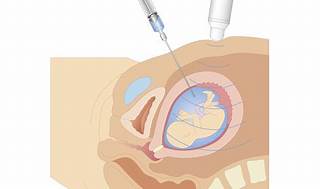A nurse is receiving change-of-shift report for a group of clients.
Which of the following clients should the nurse plan to assess first?
client who has a hip fracture and a new onset of tachypnea
client who has diabetes mellitus and an HbA1c of 6.8%.
A client who has epidural analgesia and weakness in the lower extremities
A client who has sinus arrhythmia and is receiving cardiac monitoring
The Correct Answer is A
The correct answer is choice A. A client who has a hip fracture and a new onset of tachypnea.
This client has a high risk of developing a pulmonary embolism, which is a life-threatening condition that requires immediate intervention.
Tachypnea is a sign of respiratory distress and hypoxia, which can indicate a pulmonary embolism.
The nurse should assess this client first and notify the provider.
Choice B is wrong because a client who has diabetes mellitus and an HbA1c of 6.8% is wellcontrolled and does not need urgent attention.
The normal range for HbA1c is 4% to 6%, and the goal for diabetic clients is less than 7%.
Choice C is wrong because a client who has epidural analgesia and weakness in the lower extremities is expected to have some degree of motor impairment due to the medication.
The nurse should monitor the client’s sensation, movement, and pain level, but this is not a priority over choice A. Choice D is wrong because a client who has sinus arrhythmia and is receiving cardiac monitoring is not in immediate danger.
Sinus arrhythmia is a normal variation of heart rhythm that occurs with breathing.
The nurse should observe the client’s vital signs and cardiac rhythm, but this is not a priority over choice A.
The correct answer is choice A. A client who has a hip fracture and a new onset of tachypnea.
This client has a high risk of developing a pulmonary embolism, which is a life-threatening condition that requires immediate intervention.
Tachypnea is a sign of respiratory distress and hypoxia, which can indicate a pulmonary embolism.
The nurse should assess this client first and notify the provider.
Choice B is wrong because a client who has diabetes mellitus and an HbA1c of 6.8% is wellcontrolled and does not need urgent attention.
The normal range for HbA1c is 4% to 6%, and the goal for diabetic clients is less than 7%.
Choice C is wrong because a client who has epidural analgesia and weakness in the lower extremities is expected to have some degree of motor impairment due to the medication.
The nurse should monitor the client’s sensation, movement, and pain level, but this is not a priority over choice A. Choice D is wrong because a client who has sinus arrhythmia and is receiving cardiac monitoring is not in immediate danger.
Sinus arrhythmia is a normal variation of heart rhythm that occurs with breathing.
The nurse should observe the client’s vital signs and cardiac rhythm, but this is not a priority over choice A.
Nursing Test Bank
Naxlex Comprehensive Predictor Exams
Related Questions
Correct Answer is D
Explanation
The correct answer is choice D. The nurse should determine if the client’s health care surrogate is aware of the risks and benefits of the procedure. A health care surrogate is a person who is authorized to make health care decisions for a client who is unable to do so. The nurse has a legal and ethical responsibility to ensure that the client’s surrogate has given informed consent for the surgery, which means that they have received adequate information about the procedure, its purpose, its risks, its benefits, and its alternatives.
Choice A is wrong because sending the unsigned informed consent form to the facility’s risk manager does not ensure that the client’s surrogate has given informed consent. The risk manager is not involved in the consent process and cannot authorize the surgery without the surrogate’s consent.
Choice B is wrong because ensuring that the client’s family supports the provider’s decision for surgery is not the same as obtaining informed consent from the surrogate.
The family may have different opinions or preferences than the surrogate, and the surrogate may not agree with the provider’s decision. The nurse should respect the surrogate’s autonomy and authority to make decisions for the client.
Choice C is wrong because determining if the procedure is medically necessary for the client is not the nurse’s role.
The provider is responsible for determining the medical necessity of the surgery and explaining it to the surrogate. The nurse should not question or interfere with the provider’s judgment unless there is evidence of negligence or malpractice.
Correct Answer is C
Explanation

Explore
The correct answer is choice c. Contractions.
Choice A rationale:
Epigastric pain is not a common complication following an amniocentesis. It is more often associated with conditions like preeclampsia or gastrointestinal issues.
Choice B rationale:
Hypertension is not directly related to amniocentesis. It is more commonly associated with conditions like preeclampsia or chronic hypertension in pregnancy.
Choice C rationale:
Contractions are a significant complication to monitor for after an amniocentesis, especially at 33 weeks of gestation. The procedure can sometimes induce preterm labor.
Choice D rationale:
Vomiting is not a typical complication following an amniocentesis. It may occur due to other unrelated reasons but is not directly linked to the procedure.
Whether you are a student looking to ace your exams or a practicing nurse seeking to enhance your expertise , our nursing education contents will empower you with the confidence and competence to make a difference in the lives of patients and become a respected leader in the healthcare field.
Visit Naxlex, invest in your future and unlock endless possibilities with our unparalleled nursing education contents today
Report Wrong Answer on the Current Question
Do you disagree with the answer? If yes, what is your expected answer? Explain.
Kindly be descriptive with the issue you are facing.
